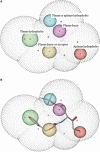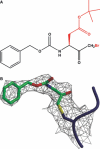Development of broad-spectrum halomethyl ketone inhibitors against coronavirus main protease 3CL(pro)
- PMID: 18611220
- PMCID: PMC2597651
- DOI: 10.1111/j.1747-0285.2008.00679.x
Development of broad-spectrum halomethyl ketone inhibitors against coronavirus main protease 3CL(pro)
Abstract
Coronaviruses comprise a large group of RNA viruses with diverse host specificity. The emergence of highly pathogenic strains like the SARS coronavirus (SARS-CoV), and the discovery of two new coronaviruses, NL-63 and HKU1, corroborates the high rate of mutation and recombination that have enabled them to cross species barriers and infect novel hosts. For that reason, the development of broad-spectrum antivirals that are effective against several members of this family is highly desirable. This goal can be accomplished by designing inhibitors against a target, such as the main protease 3CL(pro) (M(pro)), which is highly conserved among all coronaviruses. Here 3CL(pro) derived from the SARS-CoV was used as the primary target to identify a new class of inhibitors containing a halomethyl ketone warhead. The compounds are highly potent against SARS 3CL(pro) with K(i)'s as low as 300 nM. The crystal structure of the complex of one of the compounds with 3CL(pro) indicates that this inhibitor forms a thioether linkage between the halomethyl carbon of the warhead and the catalytic Cys 145. Furthermore, Structure Activity Relationship (SAR) studies of these compounds have led to the identification of a pharmacophore that accurately defines the essential molecular features required for the high affinity.
Figures






References
-
- Rota P.A., Oberste M.S., Monroe S.S., Nix W.A., Campagnoli R., Icenogle J.P., Penaranda S. et al. (2003) Characterization of a novel coronavirus associated with severe acute respiratory syndrome. Science;300:1394–1399. - PubMed
-
- Marra M.A., Jones S.J., Astell C.R., Holt R.A., Brooks‐Wilson A., Butterfield Y.S., Khattra J. et al. (2003) The Genome sequence of the SARS‐associated coronavirus. Science;300:1399–1404. - PubMed
Publication types
MeSH terms
Substances
Grants and funding
LinkOut - more resources
Full Text Sources
Molecular Biology Databases
Miscellaneous

